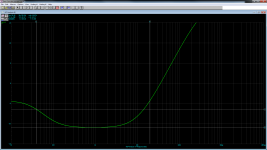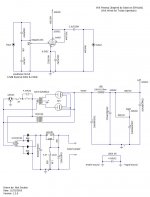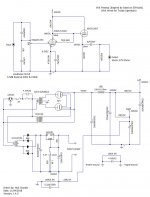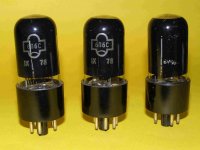I'm getting ready to build a low-gain preamp to use as the front end of an active line-level baffle-step compensation circuit, and may have to dig out my pile of 6V6 to use as the active part of it. I'll couple it to an IRF820 as a source follower. What's the gain on these with an unbypassed cathode, 5~6 or so?
Might even dig out a few 0D3s to use for a power supply
Might even dig out a few 0D3s to use for a power supply
The original circuit with the 5k plate resistor and the 680R cathode resistor but without its 1000uF bypass simulates at x3.2 voltage gain. With the bypass at x6.2 voltage gain. In reality the latter was something like 15dB or x5.6 if I remember correctly.
This just worked out perfectly for me. I have a version of this pre that uses plate chokes instead of the CCS and the sound is truly stunning (thanks Salas!) but changing power amps left me with way too much gain.
For a trail I snipped the cathode bypass caps and I now have a much more usable volume control at low levels with no apparent downsides on listening tests. Measured approx 3v with a 1v input so seems about right.
Looking at my system, with my only source being a 3V output DAC, I am seriously considering modding to the cathode buffer version. I tested that a simple inline volume pot from the DAC can drive the amp to full power so the unity gain would be perfect.
I'm a big fan of unbypassed cathodes for gain, glad to hear it worked out well for you.
What chokes are you using for plate loads?
Hi,
I actually bought the pre of another builder and he did not supply a schematic, wasn't bothered as most schematic variants were on here.
No manufacturers markings either but they do look like hammonds. Measuring in circuit gives a very small mh (19mh) so given the size of the monsters i'm guessing that's not very helpful either
if anyone knows if there are any markings/product codes inside the bell housing I'll remove and check.
ta
Rob.
Due to my varied taste in music, I have added a loudness contour to the 6V6 preamp. I don't really need full blown bass and treble control, but a little boost is always helpful, especially at low(er) listening volumes, where most of my listening is done.
The boost curves (4.5db at 40Hz and 15kHz) were set to compliment my ported La Scalas.
I have also modified the filament power supply to be switchable between 6.3V and 12.6V, so I can swap between 6V6 and 12V6 tube types.
The boost curves (4.5db at 40Hz and 15kHz) were set to compliment my ported La Scalas.
I have also modified the filament power supply to be switchable between 6.3V and 12.6V, so I can swap between 6V6 and 12V6 tube types.
Attachments
My final version of the 6V6 preamp was going to be transformer coupled (15k:600). However, a 6SN7 direct-coupled cathode follower (and it was free since I had all the parts) is just as effective to drive just about cable/amp combination. The cathode follower preserves the 6V6 magic, but with a low output impedance and some drive current.
Frequency Response: 2Hz~80kHz, -3dB
Signal to Noise: (400Hz~80kHz) 95dB below full output
Gain: 5.7
Note: The 6V6 cathode resistor in my previous post is supposed to be 470, not 270 Ohms.
Frequency Response: 2Hz~80kHz, -3dB
Signal to Noise: (400Hz~80kHz) 95dB below full output
Gain: 5.7
Note: The 6V6 cathode resistor in my previous post is supposed to be 470, not 270 Ohms.
Attachments
Personalized with some frequency shaping for particular speakers and listening habits, an extra stage with parts that were laying around i.e. customizing and readiness are strong DIY benefits. The gain at 15dB as with my original. Those old tubes were made to good standards. I also see that the cathode capacitor is moved across the full cathode resistance in the last two iterations, no split decoupling as in your first, also as found in the original.
Congrats for finishing it up
Congrats for finishing it up

I also see that the cathode capacitor is moved across the full cathode resistance in the last two iterations, no split decoupling as in your first, also as found in the original.
I needed the few dB of gain back after implementing the loudness contour and cathode follower.
Overall, this preamp sounds amazing. I highly recommend a version with a cathode follower to isolate the 6V6 from your preamp cables and amp.
Salas,
Are those Russian 6V6's any less microphonic than USA NOS 6v6's?
I needed the few dB of gain back after implementing the loudness contour and cathode follower.
Overall, this preamp sounds amazing. I highly recommend a version with a cathode follower to isolate the 6V6 from your preamp cables and amp.
Salas,
Are those Russian 6V6's any less microphonic than USA NOS 6v6's?
Or the 6V6 preamp CF version itself for those who will not strictly need line gain. Russian reissue "Tungsol" 6V6GT were good for microphonics when I got them, better than most NOS I had around. I did not have black anode RCA nonetheless. The "Tungsols" also had a clean but balanced sound. I don't know if they are still making them exactly the same as ten years ago though. They were rather newly introduced back then and many samples even had a cosmetic fault, their bottles were cemented to their bottom bases at an angle. Like the Leaning Tower of Pisa but much less dramatically so.
I needed the few dB of gain back after implementing the loudness contour and cathode follower.
Overall, this preamp sounds amazing. I highly recommend a version with a cathode follower to isolate the 6V6 from your preamp cables and amp.
Salas,
Are those Russian 6V6's any less microphonic than USA NOS 6v6's?
I did a shootout with different 6V6 or alike NOS or used a few hundred posts back. Dont remember the verdict though but it mentioned a few options if i remember correctly
Some EL90 for example did an excellent job. Dirt cheap.
Last edited:
I never thought of making a PCB for this design as it is relatively low parts count tube and almost all builders in this forum's section are experienced. Plus the parts they got vary in size. Still, another one recently asked for a more defined concept as he was inexperienced in high voltage circuits building. Maybe I have to rethink about it. It might well be a Guinness World Records worth entry for an official board to be firstly released about a DIY design only eleven years after it was firstly discussed in a forum 
I never thought of making a PCB for this design as it is relatively low parts count tube and almost all builders in this forum's section are experienced. Plus the parts they got vary in size. Still, another one recently asked for a more defined concept as he was inexperienced in high voltage circuits building. Maybe I have to rethink about it. It might well be a Guinness World Records worth entry for an official board to be firstly released about a DIY design only eleven years after it was firstly discussed in a forum
You have my eager support!
Yes, many of us. They sound good and bit melodic, also well built, but in cheap multi-piece offers there can be duds among them, like hissy or to be dying out of the blue. No problem with those offered as selected measured pairs or quads though.
Thanks for the info Salas.
Hello Salas:
I am also a relative beginner at tube amp and point to point building. I think there would be very big interest in a PCB for this circuit. There are many examples of good solid stable p-p designs that have been done as PCB's with great success. Baby Huey comes immediately to mind.
A PCB will definitely bring more DIYers into the tube world and get them excited about glass and fire.
I suggest you see if there is interest. I am interested for sure. Prasi from the BabyHuey PCB thread may be interested in being involved.
I hope this helps
I am also a relative beginner at tube amp and point to point building. I think there would be very big interest in a PCB for this circuit. There are many examples of good solid stable p-p designs that have been done as PCB's with great success. Baby Huey comes immediately to mind.
A PCB will definitely bring more DIYers into the tube world and get them excited about glass and fire.
I suggest you see if there is interest. I am interested for sure. Prasi from the BabyHuey PCB thread may be interested in being involved.
I hope this helps
- Home
- Amplifiers
- Tubes / Valves
- 6V6 line preamp



